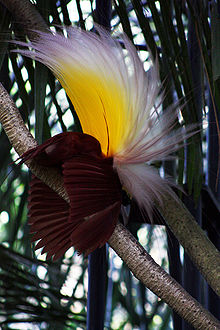
The birds-of-paradise are members of the family Paradisaeidae of the order Passeriformes. The majority of species are found in eastern Indonesia, Papua New Guinea, and eastern Australia. The family has 45 species in 17 genera. The members of this family are perhaps best known for the plumage of the males of the species, the majority of which are sexually dimorphic. The males of these species tend to have very long, elaborate feathers extending from the beak, wings, tail, or head. For the most part, they are confined to dense rainforest habitats. The diet of all species is dominated by fruit and to a lesser extent arthropods. The birds-of-paradise have a variety of breeding systems, ranging from monogamy to lek-type polygamy.

The Baltimore oriole is a small icterid blackbird common in eastern North America as a migratory breeding bird. It received its name from the resemblance of the male's colors to those on the coat-of-arms of 17th-century Lord Baltimore. Observations of interbreeding between the Baltimore oriole and the western Bullock's oriole Icterus bullockii, led to both being classified as a single species, called the northern oriole, from 1973 to 1995. Research by James Rising, a professor of zoology at the University of Toronto, and others showed that the two birds actually did not interbreed significantly.

The common iora is a small passerine bird found across the tropical Indian subcontinent and Southeast Asia, with populations showing plumage variations, some of which are designated as subspecies. A species found in scrub and forest, it is easily detected from its loud whistles and the bright colours. During the breeding season, males display by fluffing up their feathers and spiral in the air appearing like a green, black, yellow, and white ball.

The blue-crowned hanging parrot is a parrot species endemic to southern Burma and Thailand, Malaya, Singapore, and Indonesia. These parrots are 12cm in height and weight 28g and have a longevity of 14 years. They are recognized by their green plumage, black beak and characteristic blue feathers arranged like a crown on their head.
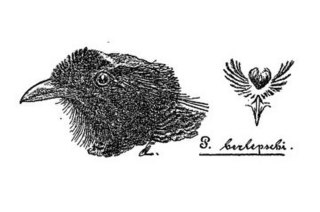
The bronze parotia, also known as the Foja parotia, Berlepsch's parotia or Berlepsch's six-wired bird-of-paradise, is a species of bird-of-paradise, in the family Paradisaeidae. It resembles and is often considered to be a subspecies of Carola's parotia, but a high majority of authorities support its specific status.

The blue bird-of-paradise is a large species of bird-of-paradise. It is the only species in the genus Paradisornis, but was previously included in the genus Paradisaea.

The genus Paradisaea consists of six species of birds-of-paradise. The genus is found on the island of New Guinea as well as the nearby islands groups of the Aru Islands, D'Entrecasteaux Islands and Raja Ampat Islands. The species inhabit a range of forest types from sea level to mid-montane forests. Several species have highly restricted distributions, and all species have disjunct distributions. A 2009 study examining the mitochondrial DNA of the family found that the Paradisaea birds-of-paradise were in a clade with the genus Cicinnurus. It showed that the blue bird-of-paradise was a sister taxon to all the other species in this genus.

The Arfak astrapia is a species of astrapia, a group of birds found in the birds-of-paradise family Paradiseidae.
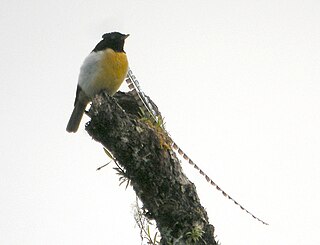
The King of Saxony bird-of-paradise is a bird in the bird-of-paradise family (Paradisaeidae). It is the only member of the genus Pteridophora. It is endemic to montane forest in New Guinea.

The king bird-of-paradise is a passerine bird of the Paradisaeidae (bird-of-paradise) family. It is considered by the IOC checklist to be the only member of the genus Cicinnurus, although the genus Diphyllodes is closely related and is subsumed under Cicinnurus by many other authorities.
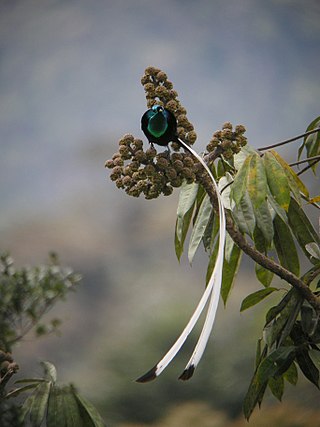
Astrapia is a genus of birds-of-paradise. The genus contains five species, all endemic to New Guinea. The males have highly iridescent plumage and remarkably long tails. Females are duller and have shorter tails.

The emperor bird-of-paradise, also known as emperor of Germany's bird-of-paradise, is a species of bird-of-paradise.
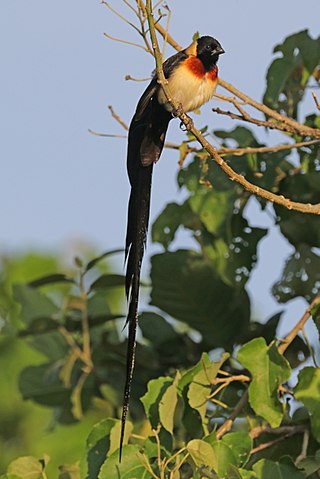
The long-tailed paradise whydah or eastern paradise whydah is from the family Viduidae of the order Passeriformes. They are small passerines with short, stubby bills found across Sub-Saharan Africa. They are mostly granivorous and feed on seeds that have ripen and fall on the ground. The ability to distinguish between males and females is quite difficult unless it is breeding season. During this time, the males molt into breeding plumage where they have one distinctive feature which is their long tail. It can grow up to three times longer than its own body or even more. Usually, the whydahs look like ordinary sparrows with short tails during the non-breeding season. In addition, hybridization can occur with these paradise whydahs. Males are able to mimic songs where females can use that to discover their mate. However, there are some cases where females don't use songs to choose their mate but they use either male characteristics like plumages or they can have a shortage of options with song mimicry. Paradise whydahs are brood parasites. They won't destroy the eggs that are originally there but will lay their own eggs in other songbirds nest. Overall, these whydahs are considered least concerned based on the IUCN Red List of threatened species.

The magnificent bird-of-paradise is a species of bird-of-paradise. The magnificent bird-of-paradise is evaluated as Least Concern on the IUCN Red List of Threatened Species. They are listed in Appendix II of CITES.
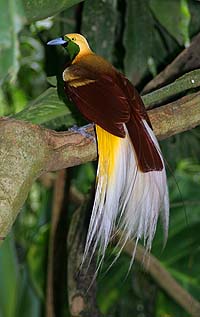
The lesser bird-of-paradise is a bird-of-paradise in the genus Paradisaea.

The Huon astrapia, also known as Rothschild's astrapia, Huon bird-of-paradise, or Lord Rothschild's bird-of-paradise, is a species of bird-of-paradise belonging to the genus Astrapia. Like most of its congeners, A. rothschildi is a rather elusive member of its genus and family.

The Raggiana bird-of-paradise, also known as Count Raggi's bird-of-paradise, is a large bird in the bird-of-paradise family Paradisaeidae.
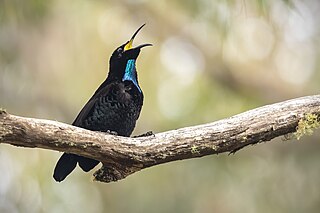
The paradise riflebird is a passerine bird of the family Paradisaeidae. It is one of four riflebird species in the genus Ptiloris. It is found in subtropical, temperate rainforests in eastern Australia. The species is sexually dimorphic; the male is black with iridescent blue-green patches, while the female is gray-brown and white.
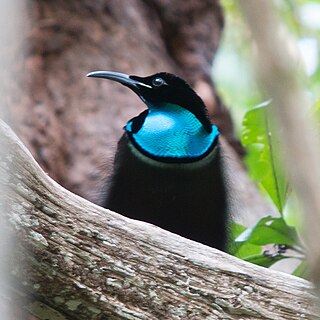
The magnificent riflebird is a species of passerine bird in the birds-of-paradise family Paradisaeidae.

The Senegal batis is a species of small passerine bird in the wattle-eyes family, Platysteiridae. It occurs in western Africa where it is found in dry savanna and subtropical or tropical dry shrubland. It was originally given the binomial name Muscicapa senegalensis by Carl Linnaeus in 1766.





